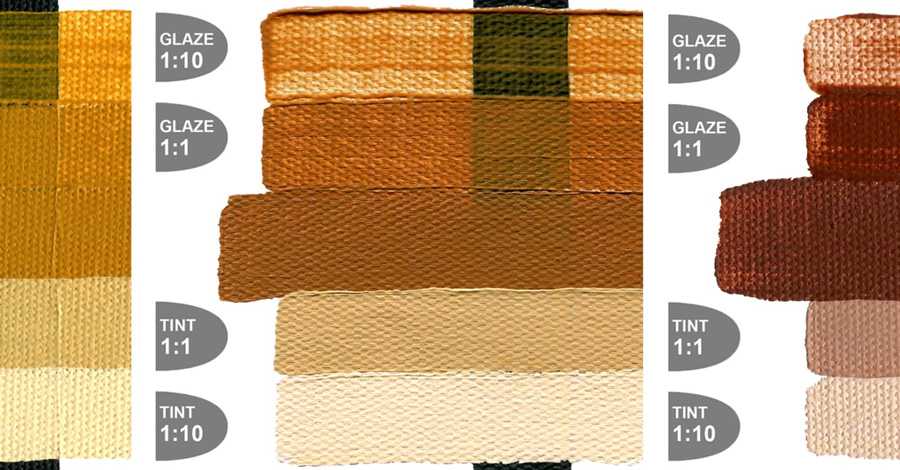COLORS
Colors No Longer Made or Never Made:
What happened to Naphthamide Maroon and is it coming back?
Naphthamide Maroon was discontinued because our pigment manufacturer stopped producing it and did not make us aware of their decision before we could secure enough for the next several years. Therefore, we lost one of our favorite paint colors and have had to work on developing a similar color to replace it. Had we been given enough lead time, we certainly would have bought enough to meet production needs for the time in which a replacement could be developed.
Unfortunately, the pigments we have looked at as viable replacements have failed one of our basic tests, which is a water and ammonia sensitivity test of the dried film. This means color would lift during varnish removal or could bleed into subsequent layers of paint. Not good at all.
However, we have been able to successfully blend the color and achieve very close approximations of it.
- 11 parts Quinacridone Violet
- 12 parts Quinacridone Burnt Orange
- 2.0 parts Dioxazine Purple
This makes a great replacement for the undertone and washes. Reduce the Quinacridone Burnt. Orange to 11 parts and add 0.7 parts Carbon Black to create the masstone. We may be introducing this blend along with several other discontinued color hues in the near future, and we have not given up on finding a single pigment replacement as well.
I scanned your site, and noticed you have an Indigo glaze, but do you have, or will you ever create, a heavy bodied Indigo paint?
True Indigo is a purplish blue fugitive dye colorant mostly used for coloring textiles. The closest single pigment to mimic Indigo is Anthraquinone Blue. The glaze color called Indigo is 10 parts Acrylic Glazing Liquid to 1 part Anthraquinone Blue. Anthraquinone Blue is available in the following GOLDEN paint lines:
- Heavy Body Acrylics
- Fluid Acrylics
- Matte Acrylics
- High Load Acrylics
- (New) Matte Fluid Acrylics
Why don"t you make a genuine Viridian Green?
We did at one time. However, it was short lived. Our first batch was produced with great success. A good alternative for Viridian Green is Cobalt Green. We now make a historical hue version called Viridian Green Hue.
Why did they quit making High Load Acrylic Cadmium Red? And what is the best comparison to Cadmium Red?
We stopped producing High Load Acrylic Cadmium Red due to lack of sales production cost. We suggest trying the Pyrrole Red, which is similar to the Cadmium Red. It is less opaque, but Pyrrole mixes with other colors much cleaner than Cadmium. There is also a Pyrrole Red Light and a Pyrrole Orange in the Fluid and Heavy Body acrylics. Diarylide Yellow and Hansa Yellow Opaque will help to round out the yellows in replacing the Cadmiums. We also have Naphthol Red Light and Naphthol Red Medium, which are fairly opaque as well, however, We find the Pyrroles are better substitutes than Naphthols.
I am looking for paint called "Moon White". It has light reflective qualities similar to those in the paint for the lines in the middle of the road. Have you heard of anything similar? This is not the pearliest paint but actually shines light back from tiny plastic balls in the paint.
You should be able to obtain the small glass beads without any binder and blend them with GOLDEN Soft Gel Gloss or GAC 500.
We"ve looked at making this product, but did not find they had much appeal for the fine artist to warrant making a line of them as gel mediums. They are limited as to how you can use them. The beads need to be very tiny and the background needs to be either a bright white or Iridescent. Additionally, the beads must be applied absolutely uniform in order to get the reflective nature. Anything less than a perfect deposit of a single layer of beads usually resulted in a fish egg effect or trapped air bubbles effect.
Why is it so difficult to make a pure lightfast magenta? If I mixed Fluorescent Magenta with other colors, I realize the "glowing" nature would disappear quickly but how long would the pure magenta quality of the color last?
Magenta colorants are high key compared to other pigments. They have to be very transparent and bright. As a result they do a very poor job of resisting light. Natural sources, for example madder, is a naturally occurring dye colorant. Our first Quinacridone Magenta pigment we used was rated II, which is decent and acceptable for artists" use. GOLDEN only uses pigments rated either I or II, as III means after 100 years of gallery lit conditions there will be dramatic shift in color such as fading or darkening. Rating II means after the same time there is a slight change, and I means there is no perceivable change in color.
If you find the blueness of the Quinacridone Magenta bothersome try the Quinacridone Red. It has good lightfastness and before we found the Quinacridone Magenta pigment we now use, the Quinacridone Red was our primary recommendation.
We strongly suggest not using Fluorescent Magenta for your palette, as it has very poor lightfastness (it"s a pigmented dye) and mixtures with it get muddy immediately, even with other Fluorescents!
We hope to one day offer nothing but I rated pigments, but the reality is, until the pigment manufactures can produce the same brightness of color, we have to continue to use the ones we have. The same deal with the Fluorescents, which are more fugitive than alizarin. There is NOTHING lightfast that can equal their brightness, so we offer them, and do our best to indicate these colors are going to fade rapidly. They are our only exception to the I & II rated rule here at GOLDEN.


